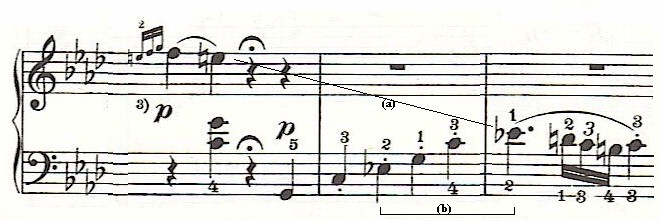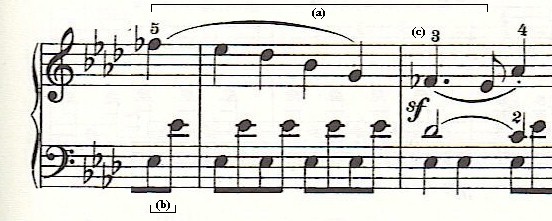Cadential Structure in Beethoven's Op. 2 No. 1 (First Movement), continued |
| The opening motive of the second theme goes down and flips back up at the end, just as the opening motive of the first theme went up and flipped back down at the end, and the rhythm of the two ideas is almost identical. Other than that, there is a world of difference. Especially that f-flat. |
| Let's go back to measures 8 through 10. The opening theme ends on the e-natural an octave and a major third above middle c. The transition begins with a statement of the opening motive in a lower octave, arriving on the e-flat an octave lower than the e-natural (Example 241.3a, at (a)). Instead of suggesting a chromatic descent, it suggests a cross-relation: e-flat against e-natural, an octave apart. Oddly enough, the second theme begins on the f-flat enharmonic equivalent of the e-natural and proceeds to descend to the e-flat an octave lower (Example 241.3b, at (a)), emphasizing the f-flat to e-flat dissonance and resolution with a sforzato (at (c)) - as though someone had pointed out the implied cross-relation to Beethoven, and he had replied with a sforzato "I know that!" Notice, also, the e-flats, an octave apart, in mm. 9-10 (Example 241.3a, at (b)), preparing the e-flat octave accompaniment figure in mm. 20-25 (Example 241.3b, at (b)). |
| The f-flat also serves to distract us from noticing that between measure 11 and measure 25, we hear the descending motive e-flat to g-natural no less than six times in the same register. We've been hearing this second thematic motive since measures 7-8. In addition, the first and last note of this motive as heard in measures 20 through 24 are f-flat and the a-flat a minor sixth below - again, the minor sixth idea. |
| Harmonically, we have a prolonged statement of the dominant, which eventually resolves to the initial structural tonic in measure 33. The bass reiterates the thematic three-four-five pattern (from mm. 7-8 and 16-20) twice before completing the cadence in measure 41. A brief codetta follows. |
| The codetta melody (mm. 41-43, and repeated twice in mm. 43-48) is a compression of the opening theme: a rise up to the minor third of the scale (mm. 1-2 and m. 41), a scalewise descent to the leading tone (m. 2 and mm. 41-42), and concluding with a descent from the dominant note (mm. 7-8 and m. 43). The relationship is more obvious at the end of the movement (mm. 139-152), where the codetta (extended into a brief coda) is in the same home key of f minor as the opening theme. |
| The initial motif of the codetta (d-natural grace-note, c-flat, b-flat, a-flat) reiterates the idea heard in mm. 33 and 37. The harmonic idea was first introduced in mm. 15-20 as a motion from the dominant of the dominant to the dominant itself (or a tonic six-four chord which resolves to the dominant, in mm. 42, 44 and 46), but is rooted in the embellishment motif in m. 10 (which in turn refers back to m. 2). |
| Every detail in this movement seems to grow out of the first eight measures. Our analysis of the development section will show how the larger design - the cadential structure - grows out of those same first eight measures. |
| Example 241.3a |
| Example 241.3b |
 |
 |
 |
Introduction The Chaconne Cadential Structure --- Unitary & Binary Structures Linear & Periodic Structures Modules and Modalities Structural Counterpoint Modular Composition Appendices |
| MODULES Cadential Structure In Symphonic Composition: Analysis of Beethoven's Op. 2 No. 1 (First Movement), continued Lester Allyson Knibbs, Ph.D. |
| Sonata Movements Op. 2 No. 1 (I) 1 2 3 4 Op. 10 No. 1 (I) |